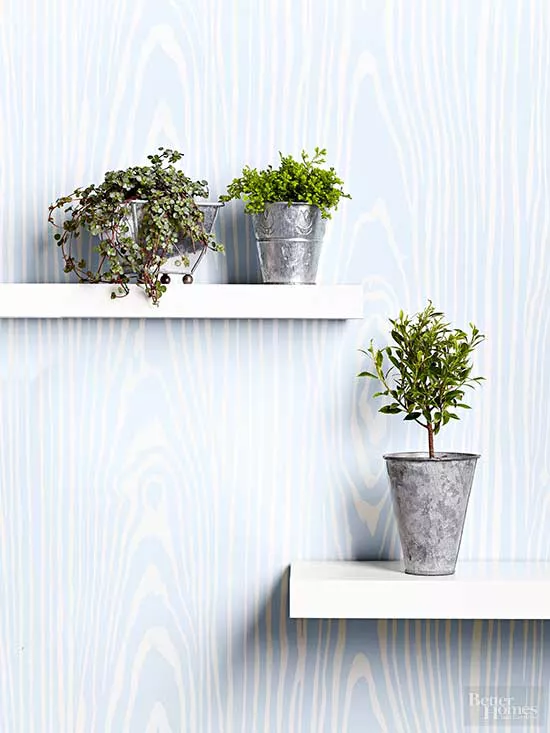Fairy gardens are sometimes called miniature gardens, and it's true, these postage-stamp plots do require the most petite of plantings. But these whimsical little gardens offer so much more than small-scale greenery. They bring a touch of magic to your landscape, with their shrunken structures, miniature garden plants, and fairy statues. Whether you're planting your tiny garden in an indoor container or tucking it into an outdoor nook, these little flowers and shrubs will spark your imagination as you plan your layout.
1. Silver Sprinkles Plant (Top Left)
A type of pilea, this gray-and-silver plant forms a low, tangled groundcover, setting down roots along the stems. Allow the top inch of soil to dry before watering, and protect the plant from hot afternoon sun.
2. Spikemoss (Top Right)
Sometimes called clubmoss, this fern-like plant thrives in humid terrariums. It grows very slowly, but once mature, can create a dense carpet of green foliage.
3. Miniature Fig Tree (Bottom)
The leaves of the 'Tiny Limey' miniature fig are smaller than those of other Ficus microcarpa. This plant works equally well for bonsai or miniature gardens and prefers well-drained, but moist soil.
4. Polka-Dot Plant
Available in pink, red, or white, this is a favorite of fairy gardeners. Its variegated leaves contrast beautifully with other types of foliage. Pinch the tips to keep it down in size.
5. Gray Lavender Cotton
This Mediterranean herb's aromatic gray and green foliage can withstand regular trimming and shaping, making it a good candidate for a fairy garden. Despite its name, gray lavender cotton's midsummer blooms are actually bright yellow. Once it's established, this perennial is very drought-tolerant.
6. Mexican Heather
This pretty shrub can be kept small with pruning, and it can even be shaped into a topiary. Regular water and full sun will keep the Mexican heather blooming. Since it's heat-tolerant, it's a good candidate for an outdoor fairy garden.
7. Golden Japanese Stonecrop
This low-growing bright golden sedum can create a carpet-like covering amongst your other miniature garden plants. It enjoys gentle morning or evening sun. Hot midday sun will beat it down, although it can tolerate hot weather and withstand drought.
8. Wood Sorrel
This noninvasive type of wood sorrel shows off pink and purple leaves all the time, and it sports bright yellow flowers when in bloom.
9. Fuschia Begonia
This tiny begonia looks similar to a fuschia, but it really is a begonia. Allow it to dry a bit between waterings, and give it morning sun, while shielding it from afternoon rays.
10. Elfin Thyme
Elfin thyme forms a very low mat of ultra-tiny green leaves, then bursts forth with deep-pink blossoms in late spring. It requires regular watering in well-drained soil and fares best outdoors.
11. Variegated Artillery Plant
Perfect for humid terrariums or fairy gardens, this pilea needs occasional pinching at the tips in order to stay small. Look for the plain green-leafed version, too.
12. Dwarf Umbrella Plant
Schefflera make a nice choice for those new to bonsai. Water thoroughly only after the soil becomes very dry, and pinch the tips of the leaves to shape the plant.
13. Miniature Oakleaf Creeping Fig
With a preference for low light and high humidity, this pretty little vine is a good choice for terrariums or moist dish gardens. The charming foliage resembles miniature oak leaves.
14. Coleus
Upright coleus with small leaves make a bright focal point in miniature gardens. Some can be trained to a single stem by removing side foliage.
15. Ripple Peperomia
Available in burgundy or green, this little plant is a nice addition to a terrarium, growing to only about 6 inches tall. The soil should be moist but well-drained. Peperomias are known as one of the easiest houseplants to grow.
16. Bugleweed
Every spring, this leafy groundcover plant sends up bloom stalks covered in deep-blue flowers. Be aware that this plant can spread, so you should avoid planting it near your lawn. It goes dormant in cold-winter climates.
17. Golden Monterey Cypress
Soft to the touch, this dwarf cypress needs full sun to achieve its bright gold color, but that doesn't necessitate a hot climate: This petite plant prefers temperatures between 55 and 65 degrees Fahrenheit. Allow soil to dry slightly before watering.
18. Golden Creeping Speedwell
This plant forms a nearly flat carpet of small round leaves and blooms with light blue flowers in summer. Once established, it's drought-tolerant.
19. Dwarf Ixora
This small, slow-growing shrub has a naturally rounded shape. It will bloom repeatedly in full sun, as long as you make sure to regularly water it.
20. Asparagus Fern
Not actually a fern, this oddly-named plant tolerates dry indoor air better than real ferns do. Asparagus ferns prefer bright, indirect light over full shade, and the soil should be well-drained.
21. Dwarf Arrowhead Plant
This dwarf version of the popular arrowhead houseplant makes a good choice for terrariums, as it grows only 4 to 6 inches tall. The pale-pink veins on its arrow-shaped leaves bring a subtle touch of color.




















